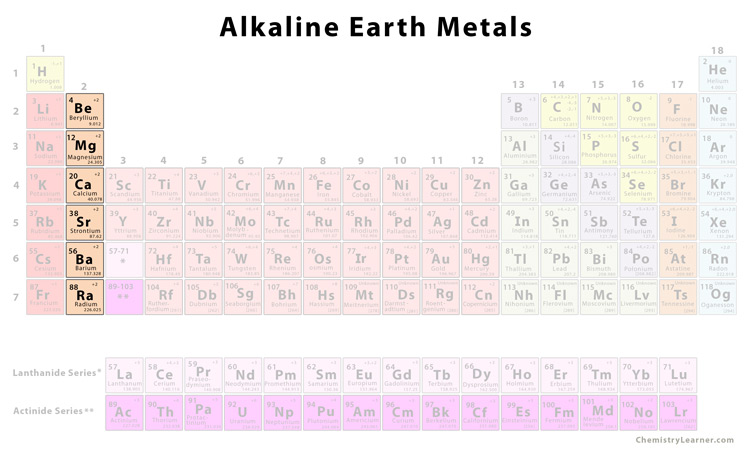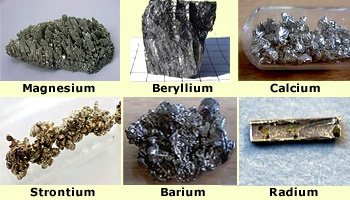Alkaline Earth Metals
Definition: What are Alkaline Earth Metals
Alkaline earth metals are a group of highly reactive elements placed right next to the alkali metal group. Although all the alkaline metals are found in nature, their high reactivity prevents them from occuring freely or in their pure form [1, 2].
Where are the Alkaline Earth Metals Found on the Periodic Table
These belong to Group 2 (the one following with alkali metal group) in the periodic table, with all the alkaline metals lying in the s-block [3, 4].
List of Alkaline Earth Metal Elements |
|
| Beryllium | Be |
| Magnesium | Mg |
| Calcium | Ca |
| Strontium | Sr |
| Barium | Ba |
| Radium | Ra |
Why are They Called Alkaline Earth Metal
The alkaline metals are named as such because when mixed with water, they produce solutions with pH higher than 7, and ‘basic’ or ‘alkaline’ properties [5]. Additionally, they are found in the earth’s crust and are not affected by fire or heat [6].
Common Properties and Characteristics of Alkaline Earth Metals
Physical Properties
- Shiny, silvery-white color
- Low density
- Low boiling and melting points [1]
Chemical Properties
- All the alkaline earth metals are highly reactive, though not as much as the alkali metals [5].
- When in contact with water, they all react strongly to form alkaline hydroxides (Beryllium is an exception as it does not react with water)
- The Group 2 elements usually form electrovalent or ionic bonds in reactions with other elements (again, Be is an exception as it forms covalent bonds) [5]
- They all react with halogens and form halide compounds [2]
Why are the Alkaline Earth Metals so Reactive
The energy required to make an atom give up the electrons in its outermost shell (valence electrons) is the ionization energy for the element. The lower the ionization energy, the more reactive an element is. Since all the alkaline metals have only two valence electrons, it takes little energy to make them give up those electrons to form cations (2+), resulting in high reactivity [7].
Beryllium (Be) does not react with water due to its small atomic size and relatively high ionization energy [8].
Reaction with Water
The alkaline metals react with water at room temperature to produce hydroxides that are almost insoluble in water, along with hydrogen ions to form a basic solution [8]. Here is how the equation looks for a reaction between calcium and water:
Ca + 2H2O ⟶ Ca(OH)2 + H2
Reaction With Oxygen
All the six Group 2 elements react with oxygen to form oxides, though not as readily as the Group 1 elements. The reaction requires heat. The following equation shows how Magnesium (Mg) would react with oxygen (O2)
2Mg + O2 ⟶ 2MgO
Alkaline Earth Metals Uses
Be and Mg are widely used in the production of alloys useful in industrial constructions including heat-resistant factory tools, as well as automobile and airplane parts. Ba has applications in various medical and diagnostic procedures like X-ray and MRIs (barium meals). The most important use for Sr is in the production of fireworks as it helps create the colorful flares. Apart from radium, the Alkali earth metals are also used in flashbulbs and batteries.
Radium, being a highly radioactive element, does not have any industrial applications at present. Earlier, it was used in luminous paints and watch dials [1, 9].
Role of Alkaline Earth Metals in Biological Systems
Mg and Ca has vital functional and structural roles in both plant and animal physiology, with Mg being present in chlorophyll molecules, while Ca is one of the primary constituents of bones. Additionally, SR is essential to the survival of a number of marine creatures, primarily various hard corals, as the element helps in shaping their exoskeletons [1, 5].
FAQ
Q 1. What is the lightest alkaline earth metal?
Ans. Beryllium is the lightest element in this family, having the smallest atomic radius.
Q 2. What is the heaviest alkaline earth metal?
Ans. Radium is the heaviest alkaline earth metal, with the largest atomic radius [10]
Q 3. What are the most common alkaline earth metals?
Ans. Calcium and magnesium are the most common alkaline earth metals
Q 4. What are the main differences between alkaline earth metals and alkali metals?
Ans. The alkali and alkaline earth metals do have some similar physical properties, but the main difference between the two is the number of valence electron. Alkaline earth metals have two valence electron, whereas alkali metals have just one. This makes the former less reactive than the latter [11].
Interesting Facts
- The alkaline earth metals are the most reactive element family after the alkali metals [5].
- The first and last element of Group 2, Be and Ra, are both toxic to living organisms [1].
- All the six elements produce colored flames when burnt: a bright white for beryllium and magnesium, red for calcium and radium, crimson for strontium, and green for barium.
- Four of the six alkaline earth elements are known to have been first isolated by English chemist Sir Humphry Davy [2].
- References
- The Alkaline Earth Metals ― Courses.lumenlearning.com
- Alkaline Earth Metals ― Ducksters.com
- S-Block Elements on the Periodic Table: Properties & Overview ― Study.com
- Group 2 Elements: The Alkaline Earth Metals ― Chem.libretexts.org
- Heading to Group Two ― Chem4kids.com
- Physical Properties of Alkaline Earth Metals ― Classnotes.org.in
- Alkaline Earth Metals: Definition, Properties & Characteristics ― Study.com
- Reactions of Main Group Elements with Water ― Chem.libretexts.org
- Everyday Uses of Alkaline Earth Metals ― Schooledbyscience.com
- Heaviest alkaline earth metal ― Guinnessworldrecords.com
- Alkali and Alkaline Earth Metals ― Technologyuk.net

